Understanding escrow: How it works in homebuying

If you’re preparing to buy a home, chances are you’ll hear the word “escrow” at some point.
Escrow refers to a financial instrument, typically an account, which is maintained by a neutral third party on behalf of two other parties engaged in a financial transaction — like a home purchase. As part of this legal process, money is held in the designated escrow account for a set period of time, such as until a particular condition is met or until the fulfillment of the purchase agreement. Closing day, in other words (if we’re talking real estate transactions).
There are several steps in the escrow process and in some cases, depending on how much money you’re putting down on a home, escrow may not be required at all. Here is what to expect in the escrow process.
How does escrow work when buying a home?
“Escrow” is short for escrow accounts. In real estate, there are three common types of escrow accounts.
Home purchase
The first type of escrow account is one used for the purchase of a home.
“The purchase agreement usually includes a provision for the buyer to provide an earnest money deposit,” explains Tom Trott, branch manager for Embrace Home Loans in Frederick, Maryland.
The earnest money deposit — generally 1 percent to 2 percent of the home’s purchase price — is held in an escrow account until the contract is finalized, after which the funds will go toward the buyer’s down payment or closing costs. If the agreement is voided, the deposit will go to either the buyer or seller, depending on what the contract stipulates.
Property taxes, homeowners insurance and mortgage insurance
The second type of escrow account, aka a mortgage escrow account, comes into play once you’ve actually purchased a home. It’s managed by your mortgage lender or servicer, and the funds in it are used to pay property taxes, homeowners insurance and mortgage insurance (if applicable).
Unresolved items in real estate contracts
A third type of escrow, if needed, involves anything unresolved in the real estate contract.
“For example, if the seller left furniture, did not complete repairs or if the property was damaged, the settlement company may hold back the seller’s funds in escrow until the contract is fulfilled,” says Trott. “Once fulfilled, the funds would go back to the seller or be used to pay for outstanding bills.”
Is escrow required?
When buying a home, putting money in an escrow account is required under certain circumstances. Typically, homebuyers are required to have an escrow account if their down payment is less than 20 percent of the home purchase.
In some cases, homebuyers are mandated by a mortgage lender to have an escrow account. If the home purchase is being paid for with a government-backed loan, like a FHA loan or a USDA loan — an escrow account will be required. The Veterans Administration (VA) does not require escrow accounts for a VA loan, but the mortgage lender used to actually finance these types of loans may require one.
Steps in the escrow process
After you successfully bid on a home and sign a purchase and sale agreement with the seller, the escrow process is initiated, which includes several phases. Your earnest money will remain in the escrow account throughout this process until you reach the final step of the home purchase, which is the closing.
1. Opening an escrow account
The first step is to open an escrow account, which is usually done by the seller, but can also be done by the buyer.
“Once an offer is made and accepted, the contract will stipulate when the escrow deposit is due,” said Ralph DiBugnara, president of Home Qualified, a real estate resource and web series. “In most cases, the deposit is split into two parts — first an initial, good-faith deposit followed by the remainder of the deposit. Usually within seven to 10 days of the contract signing.” This earnest money will eventually be applied to your overall down payment on the home.
The agent holding the escrow account could be a title business specializing in real estate, a bank or other financial firm, or it could be a private third-party entrusted with the task. Alternatively, a real estate attorney can manage this process, in which case it might be referred to as “settlement” instead of “escrow.”
2. Appraisal and home inspection
Your mortgage lender will order an appraisal of the home. If the appraised value of the home is less than the proposed purchase price, your lender will not grant you the funds for your mortgage unless you’re willing to pay the difference in cash or the seller agrees to lower the price to the appraised value.
As the buyer, you have the option to hire a home inspector to carefully evaluate the home and its habitability. It’s an important step in the escrow process that allows homebuyers to get a deeper look at the condition of the property, including its structural integrity, electrical and plumbing systems, heating system and more.
“Most responsible real estate agents advise against waiving an inspection,” said Katie Severance, a Realtor with Douglas Elliman in Palm Beach, Fla.
You’ll also want to review disclosures from the seller. The seller is obligated to report known negative conditions or flaws that presently exist with the home, such as the presence of lead paint or asbestos.
3. Obtaining insurance coverage
Your mortgage lender will require you to obtain homeowners insurance for the property, and to pay for title insurance. Unless you get an additional owner’s policy, title insurance primarily protects the lender from any legal challenges that could surface from defects with the home’s title or ownership.
4. Final walkthrough
Assuming all goes well with the appraisal and inspection — and nothing changes in your financial situation that could derail your mortgage approval — you’ll have an opportunity to visit the home just prior to closing for a final walkthrough. This helps ensure there’s no new damage to the home and that the seller has fulfilled the terms of the purchase contract, such as leaving behind appliances or fixtures they agreed on.
“The purpose of the walkthrough is to confirm that the home is in the same condition that it was on the day of the inspection,” said Severance. “Things to be done include walking the entire exterior of the property looking for any obvious issues.“
It’s also a good idea to check that the home’s water pressure is still good and that there haven’t been any plumbing problems, which can be checked by running all of the home’s water sources including sinks, faucets, tubs, showers, and the dishwasher, says Severance.
Unless a major issue is discovered, buyers are generally not allowed to back out of the purchase at this stage.
5. Closing
At least three business days prior to closing the transaction, you’ll receive a closing disclosure document from your lender with a finalized list of closing costs, including escrow amounts, Orlando says. Compare this to your loan estimate (which you received when you applied for the loan) to ensure there aren’t any material changes to the costs.
When it’s time to close, the escrow agent will create a document naming you as the homeowner and file it with the local records office, then wire the funds to your escrow account so the seller and seller’s lender can be paid. For the remaining down payment and closing costs, you’ll need a cashier’s check.
Escrow accounts for homeowners
After you buy your home, a different kind of escrow account is managed by your mortgage lender or servicer, with the funds in this account being used to pay your property taxes, homeowners insurance and (if you’re required to have it) mortgage insurance.
Your lender will divide these yearly costs by 12 months and add them to your monthly mortgage payment. When your property taxes, homeowners insurance or mortgage insurance bills are due, the mortgage servicer or lender will pay the bills on your behalf automatically from your escrow account balance.
Once each year, typically at year’s end, you’ll receive an escrow account statement, which includes information about the costs of your insurance and property taxes, and also details whether you have any shortage or surplus in your escrow account at year’s end. These statements also indicate whether your escrow payments will increase, decrease or stay the same in the coming year.
Maintaining an escrow account can lend peace of mind — it ensures your bills are paid on time, and you won’t have to keep track of them, Holsted says. Many homeowners opt to have them for this reason.
If you’ve chosen to have a mortgage escrow account for convenience, you usually can close it at any time. If the escrow account has been mandated by your lender, it gets more complicated. You might be able to terminate a mortgage escrow account eventually, although the restrictions for doing so vary from lender to lender. You’ll need to be in good standing with your payments, says Solomon. And often, to have built up at least 20 percent equity in your home, meaning you no longer have to pay mortgage insurance.
You may also like

Home insurance adjusters: what they do and how claims are paid


Escrow insurance: What is it and when do you need it?



